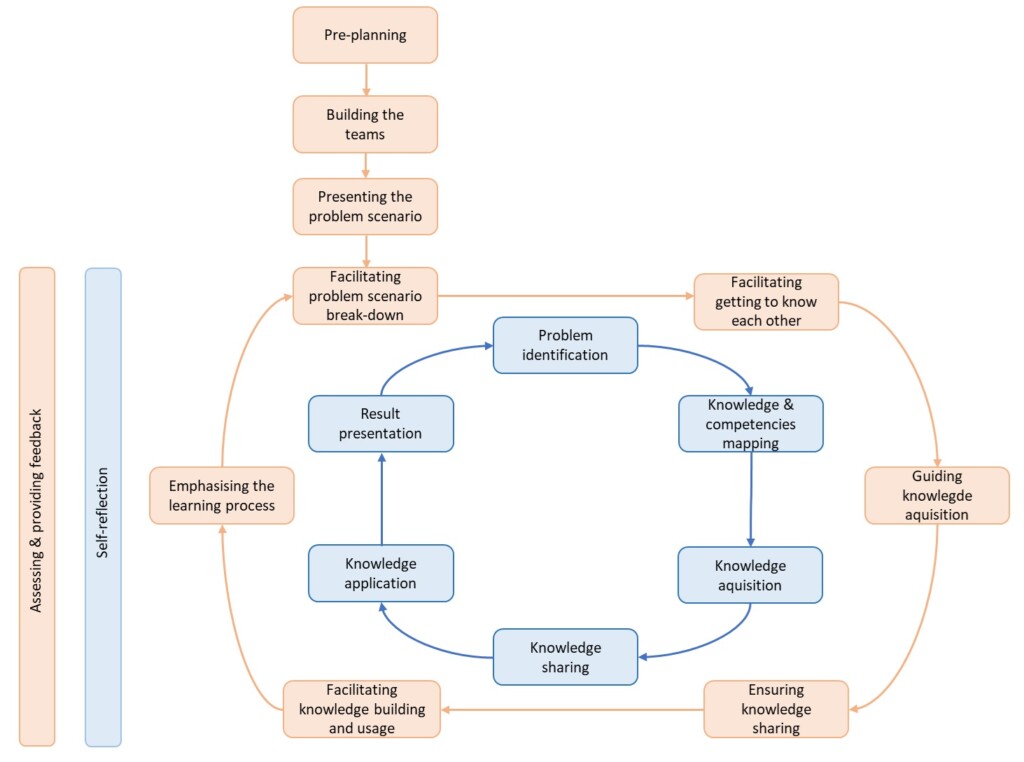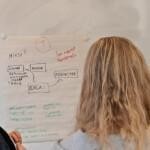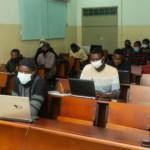
Satu Määttänen & Ulla-Maija Knuutti
Relevant competencies in the world of work are much more than just content knowledge. To be able to solve current and future problems, contribute to societal development, innovate, and add value, it requires a wide range of soft skills and transferrable competencies. Problem-based learning (PBL) is acknowledged to be an effective method to deliver these “core” skills, such as analysis skills, creative and crucial thinking, and teamwork skills, to students (e.g. Abbey et al., 2017; Ding et al., 2014; Filmer & Fox, 2014).
The theory and benefits of PBL are widely presented in academic and professional literature. However, converting theory to practice is easier said than done. PBL emphasises the students’ responsibility and active role in the learning process and sees the teacher mainly as a facilitator of the learning (Weimer, 2002). This, however, does not mean that the teacher is let off easy. On the contrary, PBL requires much thought and work from the teacher, it just differs from the traditional mode of preparing slides, lecturing, and grading exams.
In this article, we present the PBL “cycle” from both the teachers’ and students’ points of view, but with more emphasis on the teacher. The article is based on the first-hand experiences of the main author of the article.
The full PBL cycle
The PBL cycle, i.e. the phases to implement PBL, is, in most cases, presented from the student’s point of view, focusing on what the students must do during the learning process. This, however, provides only a partial picture of the actual process of PBL, as it leaves most of the teacher’s work invisible. The “full” PBL cycle, from both teachers’ and students’ perspectives (Figure 1), can be categorised into various phases and responsibilities, represented below with teacher responsibilities marked with (T) and students’ with (S).
1. Pre-planning of the learning process (T)
This part of the cycle takes the bulk of the teacher’s time and resources but makes the rest of the work easier. We can guarantee that the phrase “Well planned is half done”, is completely true in PBL.
For easier digestibility, the pre-planning phase can be divided into various sub-tasks: (i) Familiarising with the learning outcomes, as it all starts with the curricula and the predefined learning outcomes: What kind of competencies the students are supposed to learn? (ii) Creating the problem scenario. Whether by the teacher alone or with an external partner, defining a real-life challenge situation that will be the starting point for the students’ work: What kind of challenge would motivate the students and guide them to work towards the learning outcomes? (iii) Ideating the student exercises/tasks and planning the course timing. Designing different tasks for the students to provide structure and timelines for the learning process: What kind of tasks would assist students in developing the desired learning outcomes? (iv) Creating the evaluation framework. Planning, how, when and based on what the students will be assessed and evaluated, and what tasks or outcomes you are emphasised to demonstrate the achievement of the learning outcomes.
After everything is planned, the teacher is set to go. It’s time to start the course.
2. Creating a safe learning environment (T)
The Teacher starts by creating – and after maintaining – a safe and open learning environment that facilitates creative thinking, team spirit, and learning. It is also advisable for a teacher to present him/herself to students without being too formal. It encourages students to turn to the teacher when they need help.
3. Building the teams (T)
The teacher divides the students into functional teams, paying attention to the student characteristics and team size (Määttänen et al., 2022). The student teams should be provided with tools and tasks to get to know each other and to build trust.
4. Presenting the problem scenario (T)
The teacher presents the real-life challenge situation and its background to the students.
5. Identifying and defining the problem (S)
Based on the problem scenario, the students isolate and define an individual “problem” or a “case” they want to work with.
6. Facilitating problem identification (T)
The students may feel overwhelmed by the problem scenario, and no wonder, in real life, challenges are chaos(es). The teacher should help students and student teams to break down the problem and find viewpoints interesting to them.
7. Understanding the problem and team competencies (S)
Students map the existing team knowledge and competencies, define team roles and responsibilities, and identify what kind of knowledge is needed to develop solution(s) to the problem.
8. Facilitating team meetings and information acquisition (T)
The teacher should not tell students what to do or lecture them. Instead, the teacher is recommended to ask guiding questions; “Did you consider this….”
9. Acquiring knowledge and applying it (S)
Students acquire knowledge and data from various sources. Students share the acquired knowledge and insights within and among the teams. Students apply the acquired knowledge to develop solutions to the problem.
10. Facilitating knowledge building and application (T)
The teacher facilitates the student team meetings and provides platforms/sessions among the teams to ensure knowledge sharing. The teacher should not lecture but allow the students to teach each other, innovate and provide guiding questions if needed.
11. Presenting the results (S)
Students present the developed solutions orally, in written form, or by some other means. Presenting is also a part of the learning process, as teaching others is one of the most efficient ways of learning.
12. Emphasising the learning process (T)
The teacher should provide students an opportunity to practice communication skills by presenting their solutions. It’s important to remind the students – and the teacher, too – that the process is and was about learning, not the final output.
13. Self-reflection (S)
Throughout the cycle, students self-reflect their learning.
14. Assessing and providing feedback (T)
The teacher assesses and provides feedback to students throughout the learning process, as well as methods and tools that aid students’ self-reflection. The teacher should also assess and evaluate him/herself and the learning process performance. What worked well and what not? What could you do better next time?

It is important to understand that in the real-world setting, the PBL phases do not follow each other neatly and linearly, but the students, and thus, the teacher also, will bounce from one phase to another. This is why teachers in PBL need to cope with chaos and messiness (Weimer, 2002). We also want to emphasise that the students’ and teachers’ phases occur parallel rather than linearly, with the teachers constantly facilitating students, being ready to improvise and change plans if needed.
Fail, learn, and try again
We understand that implementing PBL, especially for the first time, is not easy for the teacher despite how many guidebooks there are to help. Thus, don’t be afraid of failing. On the contrary, consider yourself lucky if you fail, as that is the best way to learn and improve. Analyse the shortcomings and pitfalls by yourself and together with the students and learn from them.
The more familiar you get with the practice, the more you will succeed. After some time, facilitating PBL comes as much of a routine for you as giving lectures. Maybe after a few years, you will be the one writing PBL guidebooks, based on your experiences, to help others.
Authors
Satu Määttänen, M.Sc. in Agricultural Sciences and M.Sc. in Environmental Science and Policy from the University of Helsinki. She works as a Project Expert at the HAMK Bio Research Unit.
Ulla-Maija Knuutti, M.Sc. in Rural Development from Häme University of Applied Sciences. She works as a Senior Lecturer at HAMK Edu Research Unit.
References
Abbey, Lord, Dowsett, E., & Sullivan, J. (2017). Use of problem-based learning in the teaching and learning of horticultural production. Journal of Agricultural Education and Extension, 23(1), 61–78. https://doi.org/10.1080/1389224X.2016.1202846
Ding, X., Zhao, L., Chu, H., Tong, N., Ni, C., Hu, Z., Zhang, Z., & Wang, M. (2014). Assessing the effectiveness of problem-based learning of preventive medicine education in China. Scientific Reports, 4(1), 5126. https://doi.org/10.1038/SREP05126
Filmer, D., & Fox, L. (2014). Youth Employment in Sub-Saharan Africa. https://doi.org/10.1596/978-1-4648-0107-5.
Määttänen, S., Knuutti, U.-M., & Laitinen, E. (2022). Building effective student teams in problem-based learning. HAMK Unlimited Professional, 26.9.2023. https://urn.fi/URN:NBN:fi-fe2022062047879
Weimer, M. (2002). Learner-centered teaching: five key changes to practice (1st ed.). Jossey-Bass.





